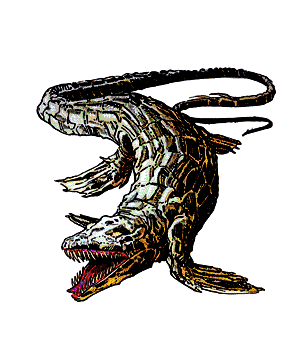

2140

| Lesser | Greater | |
|---|---|---|
| Climate/Terrain: | Deserts | Deserts |
| Frequency: | Rare | Very rare |
| Organization: | Solitary/Small herds | Solitary |
| Activity Cycle: | Any | Any |
| Diet: | Carnivore | Carnivore |
| Intelligence: | Low (5-7) | Low (5-7) |
| Treasure: | U | U(�2) |
| Alignment: | Chaotic neutral | Chaotic neutral |
| No. Appearing: | 1 or 2-5 | 1 |
| Armor Class: | 2 | 1 |
| Movement: | 15 | 12 |
| Hit Dice: | 1-5 | 6-20 |
| THAC0: | Varies | Varies |
| No. of Attacks: | 2 | 2 |
| Damage/Attack: | 3-18/1-12 | 3-36/2-24 |
| Special Attacks: | Swallow whole | Swallow whole |
| Special Defenses: | Nil | Nil |
| Magic Resistance: | Nil | Nil |
| Size: | L to G (10-50’ long) | G (60-200’ long) |
| Morale: | Average (9) | Steady (11) |
| XP Value: | Variable | Variable |
Hatori, sometimes called the “crocodiles of the sands” are giant reptiles dwelling within sandy desert wastes. The hatori’s hard, knobby hide ranges in color from gray-white to red-brown and is virtually indistinguishable from stone. Hatori use this semblance to great advantage, allowing the wind to partially bury them beneath the sands so that a casual observer may believe he is looking at rock outcroppings instead of behemoths of the sands.
Hatori are shaped like overgrown lizards, save that their legs have evolved into flat, flipper-like appendages that they use in conjunction with their massive tails to “swim” through the sands with astonishing speed and mobility. When forced to travel upon something more solid, such as a rocky plain, hatori move by awkwardly flopping and dragging themselves forward. Hatori eyes are normally concealed deep within dark recesses that look like small hollows. In the case of greater hatori (6 HD and over) these recesses sometimes look like cavern entrances.
Greater hatori are identical to lesser hatori in all respects save size and their ability to swallow larger prey whole (see below).
Combat: The only thing that can drive hatori into combat is hunger. Unfortunately, hatori have voracious appetites and food is rare in their home environment, so they never pass up an opportunity to make a meal out of a passing traveler — or even an entire caravan. The hatori’s favorite hunting method is to position themselves along a well-used migratory trail or caravan route. When, believing the hatori to be no more than a rocky outcropping, a prospective meal passes nearby, the hatori spring into action.
Once the battle begins, hatori try to bite their victims with their toothy maws. Greater hatori swallow man-sized victims whole on a natural attack roll of 20. Such victims suffer 1d12 points of damage per round from the crushing and acid effects of the digestive tract. Swallowed victims cannot escape until the hatori is killed, for the muscular action of the esophagus prevents them from climbing out the throat.
Hatori use their bony tails to lash out at anyone attacking from the rear, or to attack fleeing victims while simultaneously trying to eat someone else.
Lesser hatori can swallow whole only opponents of kender size or less (on a natural attack roll of 20).
Experience points earned for defeating a hatori depend upon its number of HD. See and 32 of the Dungeon Master’s Guide to compute the XP values.
Habitat/Society: Hatori live in the sandy regions of large deserts. Because they are constantly searching for food, however, they tend to be found near migratory paths or along busy caravan routes. They stay in a productive area until food becomes scarce.
Hatori grow very slowly, at the rate of only 1-foot per year, but they keep growing throughout their lives. They accumulate Hit Dice at the rate of 1 HD every 10 years. Therefore, young hatori of 1 HD are usually 10 feet or less in length and 10 years old or younger, hatori of 2 HD are between 10 and 20 feet and between 10 and 20 years of age, etc. Females care for their hatchlings until the young reach 50 feet in length (5 HD). This is the only time when they are commonly encountered in groups, for adult hatori are solitary creatures. Female hatori accompanied by hatchlings seldom exceed 10 HD, for they generally stop bearing young after their 100th year.
Every 10 years, male hatori and young females without any offspring migrate to the center of the desert. Here the males engage in ferocious battles to win the right to breed with the females. Although no civilized man has ever witnessed these mating rituals, certain desert tribes speak of a “time of thunder when mountains die.” These legends may refer to battles occurring during the hatori mating season.
Ecology: Hatori eat anything, though they cannot digest gems or magical armor and weaponry. These items tend to accumulate in their stomachs over their long lifetimes. Hatori have no natural predators (save for each other at mating time), though it is rumored that certain kinds of dragons have been known to attack smaller hatori in times of hunger. Legends speak of a hidden hatori burial ground where ancient hatori go to die. If such a burial ground exists, it certainly abounds with gems and magical armor.

◆ 951 ◆